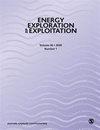碳酸盐岩埋藏丘陵的表生岩溶及其对储层发育的影响:中国北部湾盆地石炭纪威西南嵯峨岩溶案例研究
IF 1.6
4区 工程技术
Q4 ENERGY & FUELS
引用次数: 0
摘要
岩溶在碳酸盐岩储层领域得到广泛研究。本研究提出了一种新的形成机制和开发模式,特别是表生岩溶,并认为在具有面控特征的表生岩溶下,古地貌的岩溶高地和岩溶斜坡可以开发出优质储层。研究结果表明,研究区域的岩溶分为三个阶段。第一阶段为新生代岩溶,其特征是霉菌、粒内溶蚀孔隙和微裂隙化。同位素数据显示,碳酸盐岩 13C 和 18O 的变化范围与胶结物相似。第二个时期是表生岩溶,是研究区域最重要的岩溶。它的发育时间较长,具有非选择性结构溶解的特点。氧和碳同位素呈现负值(18O 从-10.033‰到-13.767‰,13C 从-2.56‰到-0.52‰),受大气降水的影响较大。第三个时期为埋藏岩溶,以缝合结构和沥青质填充为特征。方解石脉中的 18O 负值明显为 <-15‰。表生岩溶形成的溶孔和溶洞成为碳酸盐岩中油气的主要储集空间。这些岩溶呈现出面控特征,表明生物碎屑岩石灰岩岩溶发育良好,微晶岩石灰岩岩溶发育不足。该研究建立了研究区岩溶储层的开发模式,选择古地貌的高地和斜坡作为有利的勘探地点。本文章由计算机程序翻译,如有差异,请以英文原文为准。
Epigenetic karst in carbonate buried hills and its influence on reservoir development: A case study of the Carboniferous Weixi’nan Sag, Beibuwan Basin, China
Karst is widely researched in the field of carbonate reservoirs. This study proposes a new formation mechanism and development model, specifically epigenetic karst, and asserts that high-quality reservoirs can be developed in the karst highlands and karst slopes of ancient landforms under the epigenetic karst with facies-controlled characteristics. The results indicate that there are three stages of karst in the study area. The first period is syngenetic karst, characterized by molds, intragranular dissolution pores, and micritization. Isotopic data reveal that the range of variation of carbonate rock 13C and 18O is similar to that of cement. The second period is epigenetic karst, the most significant karst in the study area. It undergoes a prolonged development time and features non-selective fabric dissolution. Oxygen and carbon isotopes exhibit negative values (18O ranges from −10.033‰ to −13.767‰ and 13C ranges from −2.56‰ to −0.52‰), which are significantly altered by atmospheric precipitation. The third period is buried karst, characterized by suture structure and asphaltene filling. The negative value of 18O in calcite veins is significantly <−15‰. The dissolved pores and caves formed by the epigenetic karst become the primary reservoir space for oil and gas in carbonate rocks. These exhibit facies-control characteristics, indicating that bioclastic limestone karst is well-developed and micritic limestone karst is underdeveloped. The study establishes a development model for karst reservoirs in the study area, selecting the highlands and slopes of ancient landforms as favorable exploration sites.
求助全文
通过发布文献求助,成功后即可免费获取论文全文。
去求助
来源期刊

Energy Exploration & Exploitation
工程技术-能源与燃料
CiteScore
5.40
自引率
3.70%
发文量
78
审稿时长
3.9 months
期刊介绍:
Energy Exploration & Exploitation is a peer-reviewed, open access journal that provides up-to-date, informative reviews and original articles on important issues in the exploration, exploitation, use and economics of the world’s energy resources.
 求助内容:
求助内容: 应助结果提醒方式:
应助结果提醒方式:


